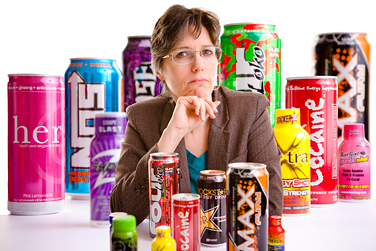News
Study links alcohol-energy drink mixes
with casual, risky sex

RIA senior research scientist Kathleen Miller says results of her study seem to indicate that energy drinks may play an role in the “hook-up culture” that exists on many college campuses. Photo: DOUGLAS LEVERE
-
 Print
Print -
 Comments
(1)
Comments
(1)
-
“AmEDs (energy drinks) have stronger priming effects than alcohol alone.”
A new study from UB’s Research Institute on Addictions (RIA) has found a link between the consumption of caffeinated energy drinks mixed with alcohol and casual—often risky—sex among college-age adults.
According to the study’s findings, college students who consumed alcohol mixed with energy drinks (AmEDs) were more likely to report having a casual partner and/or being intoxicated during their most recent sexual encounter.
The results seem to indicate that AmEDs may play a role in the “hook-up culture” that exists on many college campuses, says study author Kathleen E. Miller, RIA senior research scientist.
The problem is that casual or intoxicated sex can increase the risk of unwanted outcomes, like unintended pregnancies, sexually transmitted diseases, sexual assault and depression, says Miller. And previous research has linked energy-drink consumption with other dangerous behaviors: drunken driving, binge drinking and fighting, for example.
“Mixing energy drinks with alcohol can lead to unintentional overdrinking, because the caffeine makes it harder to assess your own level of intoxication,” says Miller.
“AmEDs have stronger priming effects than alcohol alone,” she adds. “In other words, they increase the craving for another drink, so that you end up drinking more overall.”
The good news: Miller’s study found that consumption of AmEDs was not a significant predictor of unprotected sex. Drinkers were no less likely than nondrinkers to have used a condom during their most recent sexual encounter.
Regardless of their AmED use, participants in the study were more likely to use a condom during sex with a casual partner than during sex with a steady partner, consistent with previous research. A steady or committed partner is a less risky prospect than a casual partner whose sexual history is unknown, Miller notes, so using a condom may not feel as necessary.
To be published in the print edition of Journal of Caffeine Research and available online to subscribers of the journal, the study is part of a larger, three-year research project by Miller, funded by the National Institute on Drug Abuse.
The research included 648 participants—47.5 percent female—enrolled in introductory-level courses at a large public university. They ranged in age from 18 to 40, but mostly clustered at the lower end of the age spectrum. More than 60 percent were younger than 21.
According to the study’s findings, nearly one in three sexually active students—29.3 percent—reported using AmEDs during the month prior to the survey.
At their most recent sexual encounter, 45.1 percent of the participants reported having a casual partner, 24.8 percent reported being intoxicated and 43.6 percent reported that they did not use a condom.
According to Miller, drinking Red Bull-vodkas or Jagerbombs doesn’t necessarily lead people to get drunk and become intimate with strangers, but it does increase the odds of doing so. But she points out that these drinks are becoming increasingly popular with college-age adults and should be considered a possible risk factor for potentially health-compromising sexual behaviors.
The findings may provide a basis for educational campaigns or consumer safety legislation, such as warning labels that advise against mixing energy drinks with alcohol, Miller says.

Reader Comments
chris atkinson says:
I just don't see what this study adds to our understanding of sex and alcohol use. If AmED were never created there would still be unprotected sex in the college community. Do you really think that your results would be meaningfully different if you studied people who overdrank vodka and cranberry? Your conclusion that AmED have any particular or special impact seems unfounded. Do you have any type of comparison to those who don't drink AmEd or don't drink at all? Are AmEd's more popular with binge drinkers who would binge on whatever is available - meaning that the drink itself is irrelevant? The real problem is a drinking culture that encourages massive binging and is celebrated commercially in movies, magazines, and music.
Posted by chris atkinson, Study seems to add little to the conversation surrounding sex and drinking, 07/29/12